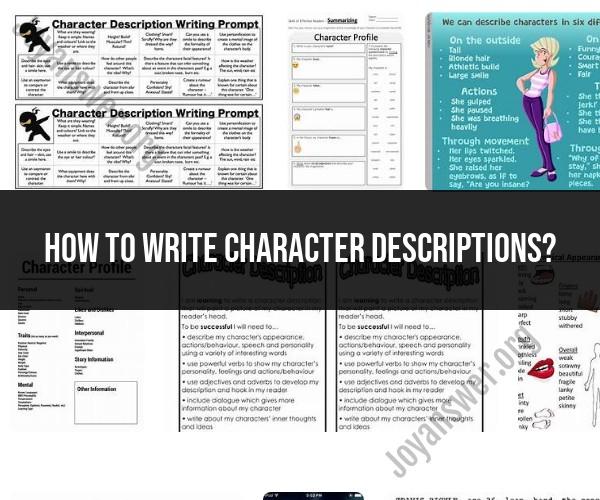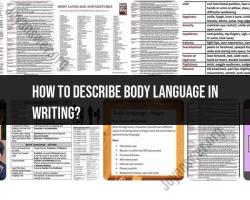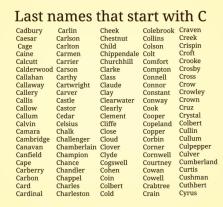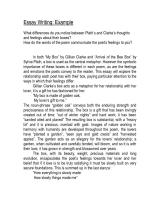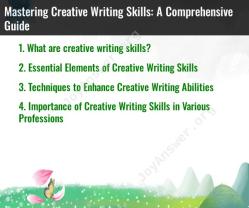How to write character descriptions?
Writing effective character descriptions is essential for bringing your characters to life and immersing your readers in your story. Here are some tips and techniques to help you create memorable and engaging character descriptions:
Show, Don't Tell:
- Instead of simply stating a character's physical traits or personality, show them through actions, thoughts, and interactions with others.
- For example, instead of saying "She was a kind person," you can show her kindness by describing how she helps a stranger in need.
Use Specific Details:
- Provide specific and unique details that make your character stand out. Consider their appearance, quirks, habits, and gestures.
- Avoid clichés and generic descriptions. Instead of saying "He had blue eyes," you could say "His eyes were the shade of a clear summer sky."
Reveal Character Through Dialogue:
- Allow your characters' dialogue to reveal their personalities, values, and emotions.
- The way they speak, their tone, and the words they choose can provide valuable insights into who they are.
Use Metaphors and Similes:
- Compare your character to something familiar to help readers visualize and understand them better.
- For example, you might describe a character's smile as "bright as a sunrise."
Consider Character Development:
- Characters should evolve and change throughout the story. Reflect this development in their descriptions.
- Show how experiences and events affect their appearance, demeanor, and outlook on life.
Balance Physical and Emotional Descriptions:
- While physical descriptions are important, don't neglect the emotional and psychological aspects of your characters.
- Describe their inner thoughts, fears, desires, and motivations.
Use Multi-Sensory Details:
- Engage the reader's senses by incorporating sensory details such as how a character smells, sounds, or even tastes.
- This can help create a more immersive reading experience.
Avoid Information Dumps:
- Don't overwhelm readers with a long list of character traits all at once. Gradually reveal information about your characters as the story unfolds.
- Provide information when it's relevant and meaningful to the plot or character development.
Show Contradictions:
- Realistic characters often have contradictions in their personalities or behavior.
- Explore these contradictions to create complex and interesting characters.
Let Readers Use Their Imagination:
- Provide enough detail to give readers a sense of your characters, but leave room for their imagination to fill in the gaps.
- Allow readers to connect with and visualize the characters in their own way.
Incorporating these tips and techniques into your character descriptions can help you create well-rounded, relatable, and engaging characters that resonate with your readers and enhance your storytelling.
Crafting Character Descriptions: Writing Tips and Techniques
Characterization in fiction is a multifaceted art that encompasses the creation of vivid, relatable characters that resonate with readers. One of the key elements in achieving this is crafting compelling character descriptions. In this article, we will explore the art of describing characters in writing, providing valuable strategies, tips, and techniques to bring your fictional characters to life.
The Power of Character Descriptions
Effective character descriptions serve as a bridge between the author's imagination and the reader's understanding. They offer readers a window into the physical appearance, personality, and emotions of the characters, fostering a deeper connection between the audience and the narrative.
Describing Characters in Writing: Strategies for Success
2.1. Show, Don't Tell
"Show, don't tell" is a fundamental principle in character description. Instead of explicitly stating a character's traits, let their actions, thoughts, and dialogue reveal who they are. For example, instead of saying, "She was brave," you might show her confronting a daunting challenge without hesitation.
2.2. Use Vivid Imagery
Paint a vivid picture of your characters in the readers' minds. Provide sensory details that allow readers to visualize the character's appearance, from their physical attributes to their clothing choices. Engage the senses to create a more immersive reading experience.
2.3. Selective Detailing
While it's essential to offer detailed descriptions, avoid overwhelming the reader with a barrage of information. Choose key details that encapsulate the essence of the character. A unique scar, a distinctive hairstyle, or a memorable accessory can often speak volumes.
2.4. Characterization Through Action
Character descriptions can also be interwoven with actions. A character's behavior, gestures, and reactions can reveal their personality. For instance, a nervous habit of tapping fingers can convey anxiety or impatience.
Characterization in Fiction: Effective Description Methods
3.1. Inner Monologue
Explore your character's inner thoughts and feelings. Let readers glimpse their internal struggles, desires, and motivations. By sharing a character's inner monologue, you invite readers to empathize and connect on a deeper level.
3.2. Dialogical Characterization
Characters' interactions with one another can be a powerful tool for characterization. Through dialogue, readers can uncover their relationships, conflicts, and personalities. Subtle nuances in speech patterns and tone can reveal a lot about characters.
3.3. Backstory and Flashbacks
Sometimes, delving into a character's past can provide valuable context and insight. Backstories and flashbacks can unveil the events that shaped your characters, making their actions and decisions more understandable and relatable.
4. Striking a Balance
While crafting character descriptions is essential, it's crucial to strike a balance. Too much description can slow the pacing of your story, while too little can leave readers disconnected from the characters. Find the equilibrium that suits your narrative style and pacing.
5. Conclusion
Crafting character descriptions is a vital aspect of storytelling. Well-crafted character descriptions breathe life into your fictional creations, allowing readers to form a deeper connection with your characters and become more engrossed in your narrative. By employing the strategies and techniques outlined in this article, you can master the art of characterization in fiction, creating characters that resonate long after the last page is turned.
